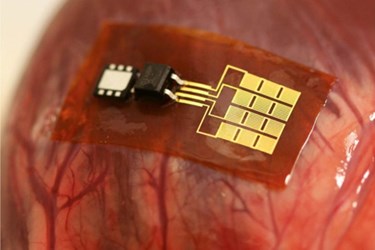Powering Medical Devices With Heartbeats And Breathing Lungs
By Joel Lindsey

An interdisciplinary group of researchers from Northwestern University, the University of Illinois at Urbana-Champaign, and the University of Arizona have developed a flexible medical device capable of capturing enough electrical power from the natural motions of a beating heart or a breathing lung to power pacemakers, defibrillators, and heart-rate monitors.
“This work is a great demonstration of engineers working with doctors and taking advantage of the natural properties of a beating heart,” Yonggang Huang, Joseph Cummings Professor of Civil and Environmental Engineering and Mechanical Engineering at Northwestern, and member of the research team, said in a press release published recently by Northwestern. “We envision this device being used to power a pacemaker with the energy coming right off the heart.”
To construct the device — which measured 2.2 cm by 2.5 cm — Huang and his team used thin ribbons of lead zirconate titanate (PZT) surrounded by a flexible, biocompatible plastic. PZT is a piezoelectric material, which means an electrical voltage is generated when it is pressed or bent.
When used in animal studies, a beating heart or a flexing diaphragm provided enough motion for the implanted device to create the electricity required to power a 3.8 volt battery , researchers said. This electricity can then be used to power other implanted devices.
“Unlike our earlier stretchable electronics work, this time we wanted strain in our piezoelectric material for the mechanical energy it produces, and our challenge was that we had to control that strain very precisely,” said Huang. “We carefully designed the device so the piezoelectric material would be pushed to nearly the breaking point, where we could capture the maximum amount of energy.”
Details regarding the device have been published recently in the journal PNAS.
Huang and his team are not the first researchers to develop such a device. As reported in an article published by Med Device Online earlier this year, a team of scientists in Ireland was awarded €6.1 million to develop a device called “MANpower.” That device uses a similar technology to convert the motion of a beating heart into electricity.
“Every time a human heart beats, it creates vibrations at a low frequency — about 1 to 30 Hz,” said Alan Mathewson, one of the researchers involved with the MANpower project. “The devices we are developing convert the vibrations from the heart into usable electrical energy, which can be used to power devices such as a pacemaker.”
Image Credit: University of Illinois and University of Arizona
